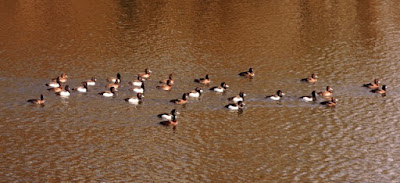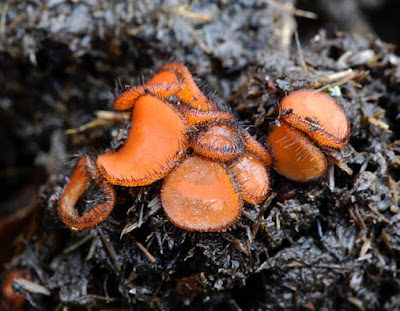And so we reach the end of 2015, as what is touted to be the warmest December on record draws to a close. The strongest El Niño event for many years has in part led to a rush of warm air from the south-west, bringing with it a series of Atlantic storms to our shores. This has meant lots of wind and rain but also exceptionally mild weather for the time of year, with temperatures in double figures for most of the month. On the 19th a high of 16 celsius was recorded here in Surrey. The mild winter isn't just affecting Britain though as unusually high temperatures have been recorded across much of northern Europe and North America, and even the North Pole where the temperature reach a balmy +1 celsius this week; over 20 degrees warmer than average for this time of year.
The consequence of all this spring-like weather in midwinter has been some exceptionally early flowering plants, and even some fresh leaves emerging on some of the trees already, but more on that later.
As usual though I'll start with a round-up of the bird life at Winkworth in the past couple of weeks.
There have been noticeably more gulls moving overhead recently, mostly Herring Gulls and mostly heading south-west first thing in the morning.
 |
| Herring Gulls |
In amongst the gulls a couple of Egyptian Geese also flew south-west over Rowe's Flashe Lake on Christmas Eve.
Egyptian Geese were also recorded flying over on the 21st and the 27th. Other noteworthy flyovers recently have included Raven, with one west on the 27th and another south-west on the 31st, and single Red Kites east on the 23rd and 24th.
Whilst opening the boathouse on the 26th I heard a 'te-zek' call high overhead and just briefly caught a glimpse of a roughly Chaffinch-sized bird disappearing over the trees, heading south, before it called again: 'tchuu'. I can't say for certain but the only bird I can think of with a call that matches that is Lapland Bunting. The sacrificial game crop fields across the Thorncombe Valley do, I know, attract good numbers of Reed Buntings and Yellowhammers at this time of year, so who's to say this bird hadn't stopped off there before heading further south?
Down at Rowe's Flashe there have been noticeably more Tufted Ducks recently, with over thirty recorded on some days towards the end of the month. Volunteer Ann Jacobs captured this nice shot of some on the 28th.
Meanwhile a Kingfisher continues to maintain a regular presence, as do the roosting Reed Buntings in the reedbed on the eastern side. There were at least three in there first thing on the 23rd
Pheasants are a familiar sight all around the arboretum, particularly so at this time of year when there's rather less vegetation for them to hide in. Volunteer Ann photographed this male in Badger's Bowl recently.
Moving on to woodland birds, and there have been plenty of Redwings, Siskins and Bullfinches around, as usual. On Christmas Eve I noted five Bullfinches along the Spring Walk, including one singing. There's also regularly been a singing Dunnock here in recent days.
Single Bramblings were noted on the 17th when one flew east and the 26th when one briefly alighted in a tree near the car park before flying south-east.
There was a Firecrest calling in the vicinity of the boathouse on Christmas Eve while on Christmas Day I was told there was one calling along the footpath just on the south-western edge of the arboretum.
The local Buzzards and Sparrowhawks have started to display over the arboretum in recent days; another surefire sign that spring is getting nearer.
 |
| Male Sparrowhawk |
Meanwhile, I noted the first drumming Great Spotted Woodpecker of the season by Rowe's Flashe early on the 31st.
Also on the 31st there was a Red Admiral on the wing, flying high around the treetops in The Bowl. The last butterfly of the year!
The more open landscape at this time of year provides more opportunities to catch a glimpse of our resident Roe Deer. I had a close encounter with this group on Sorbus Hill the other morning.
If you've visited Winkworth recently you won't have been able to miss the swathes of golden daffodils around the upper arboretum, but they are not the only floral signs of spring to be found, as the mild weather has induced many plants to flower weeks or, in some cases, months earlier than normal. Here's just a small selection of some I've noticed this past week or so:
 |
| Primrose (Primula vulgaris) - Usual flowering time: March-May |
 |
| Dog's Mercury (Mercurialis perennis) - Usual flowering time: February-April |
 |
| Wild Strawberry (Fragaria vesca) - Usual flowering time: April-July |
 |
| Common Vetch (Vicia sativa) - Usual flowering time: May-September |
However the biggest surprise for me was during the Boxing Day walk when I noticed these newly-emerging leaves on a Pedunculate Oak (Quercus robur) in Badger's Bowl.
Previous El Niño winters have ended with a blast of cold weather in February and March. If this winter follows suit then much of our flora and fauna is in for a rather nasty shock!


















































